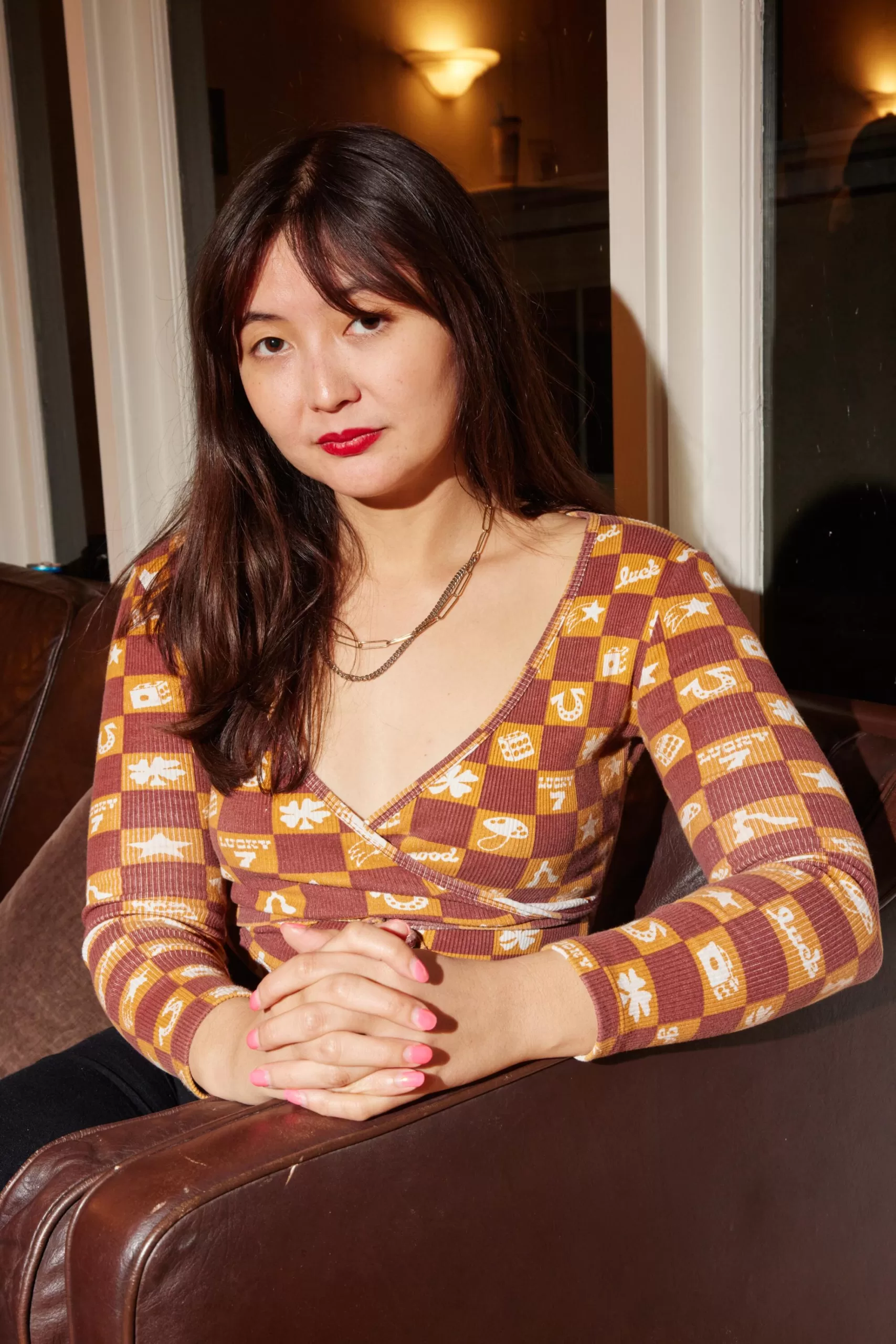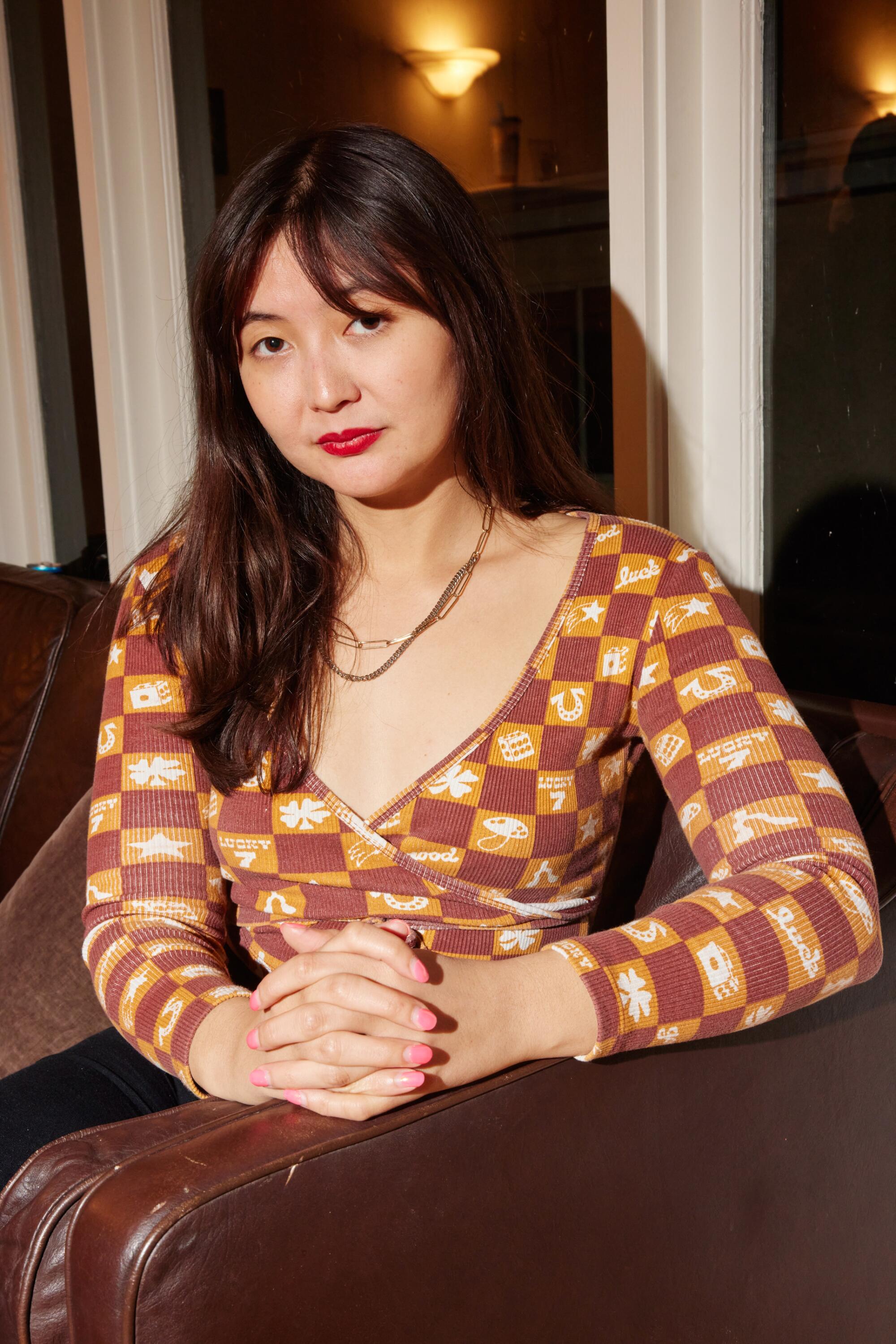
Painter Sarah Kim realized soon after her move from New York to Los Angeles that learning Texas Hold ’Em would pay off. She’d heard whispers of an ultra-exclusive, high-stakes “art game” involving L.A.’s major artists, dealers and collectors going back decades. Trailing casino chip crumbs at gallery exhibits and artist studios, “It was clear to me that poker was a huge part of the art world in L.A.,” she said.
She tried her first hand at a game artist Isabelle Brourman hosted at Murmurs Gallery and soon fell in with an eclectic poker-playing group of local artists and curators. For Kim, whose landscape motifs tackle the anxiety of belonging, the felt-topped table became her social life raft and dealt her a newfound clarity and confidence.
“Being a woman in the art world, it’s like I’m playing the same game,” said Kim, who said thinking in bets has been one way to combat the volatile and, at times, cutthroat market. “I’m fighting for a literal seat at the table.”
Kim belongs to poker’s latest wave of underdogs pouring out from the creative cultural ferment. They’ve let the air out of the cigar-smoke-filled boys’ club and opened up the tables to a more diverse, inclusive and female-friendly pool of players. The storied L.A. poker scene — an obsession Tinseltown has self-mythologized since the Wild West — these days belongs to the emergent DIY art world. But the new guard has retained the fundamentals: a game as much about networking and camaraderie as card playing.
Poker is one of the few spectator games where the sexes compete on equal levels, yet 96% of professional players are men, according to the World Series of Poker. The series’ main event in Las Vegas last summer shattered the all-time attendance record of roughly 10,000 players. Still, it’s been nearly three decades since a woman made it to the final table.
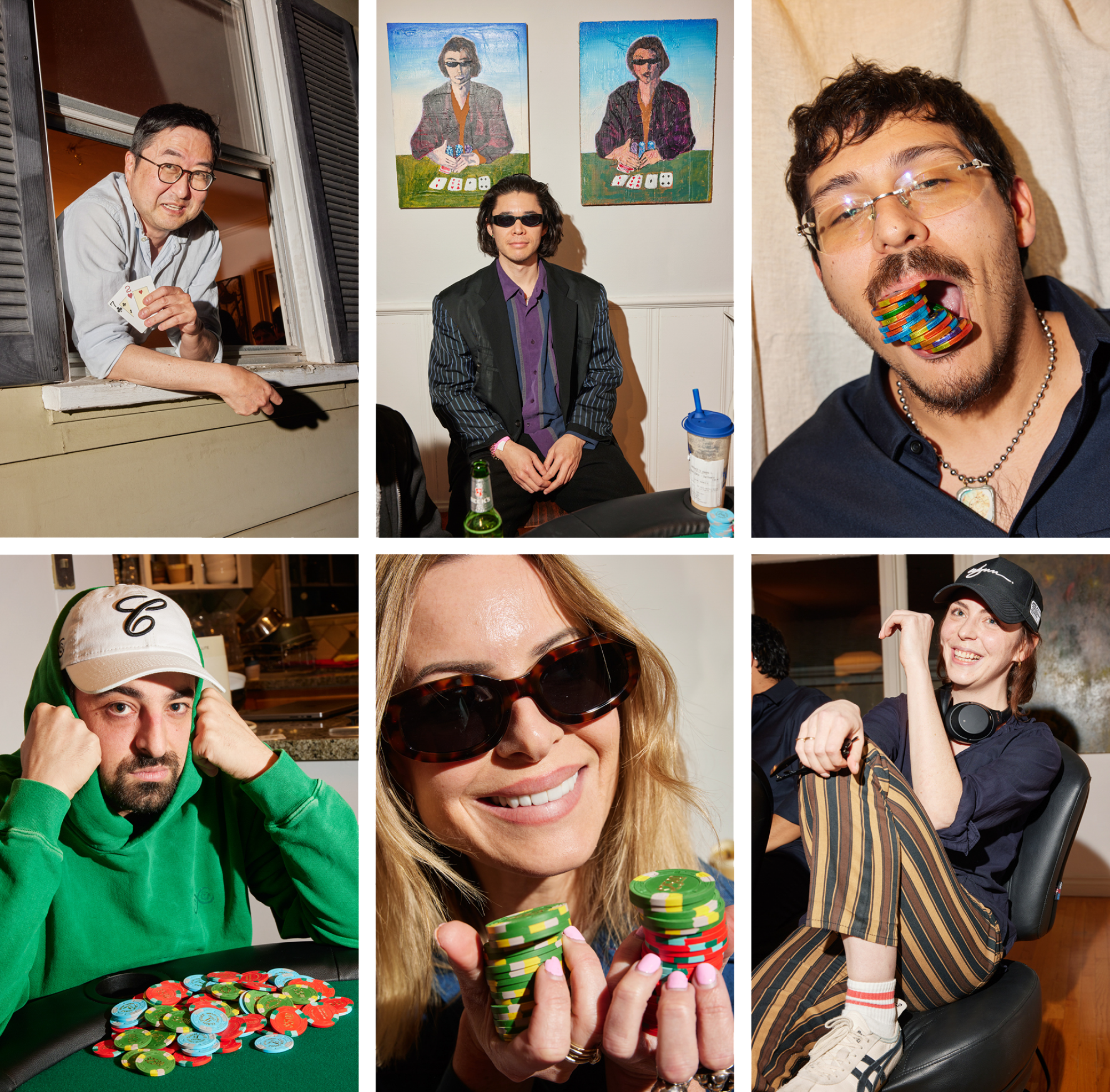
Top row: Gallerist Eric Kim, left, a poker mentor to dozens of early-career artists; Parker Ito, flanked by two self-portraits; and artist Higinio Martinez, devouring chocolate poker chips. Bottom row: Art collector Jason Roussos, left, “#Girlboss” author-turned-venture capitalist Sophia Amoruso and Lauren Studebaker, who helped organize her poker group’s DIY exhibit “At Home in the Neon.”
“Poker is not necessarily a hobby for the frugal, which is also why I think women haven’t historically played,” said Bita Khorrami of Casinola, which outfits sleek, private poker games for the cultural in-crowd. Her collaborator, Eddie Cruz — who started the streetwear boutique Undefeated — taught her the game on the promise that she’d become a better businesswoman. Khorrami, who cut her teeth in music and sports management, said it was the financial edge she needed. “When I have to counter someone in a negotiation, I’ll take a percentage of the money” from the playing funds, she said, which informs a raise, call or fold. “Whatever you’re gonna do is by percentage,” she said of bankroll management. “And the more you do those things, the more comfortable you are with it.”
Now, she and Cruz are going all in on Casinola as the first-of-its-kind creative collective and lifestyle brand rooted in poker. She joined on one condition: to not be the only woman in the cardroom. “My mission is going to be to bring women to poker,” she recalled telling Cruz. “Poker degenerates want to play with other poker degenerates,” she said. “They don’t want to be taking time necessarily to teach someone.”
They enlisted Jason Roussos, an art collector and pokerhead, to help retain their brand of backroom chic while also selling the idea of empowerment. “When things become too heavy or too reliant on one type of energy,” like the hypermasculine bro kind, he said, “that energy can take over a space.” Having more women brings a dynamic shift to the table, and lowering the barrier for entry often begins with smaller buy-ins with proper setups and dealers. Female-only live games are another incentive, like the time Casinola sponsored a poker night for Girls Only Game Club. “People sometimes use poker as a vice or form of escapism, but we’re using it as more of a socializing tool,” Roussos said.
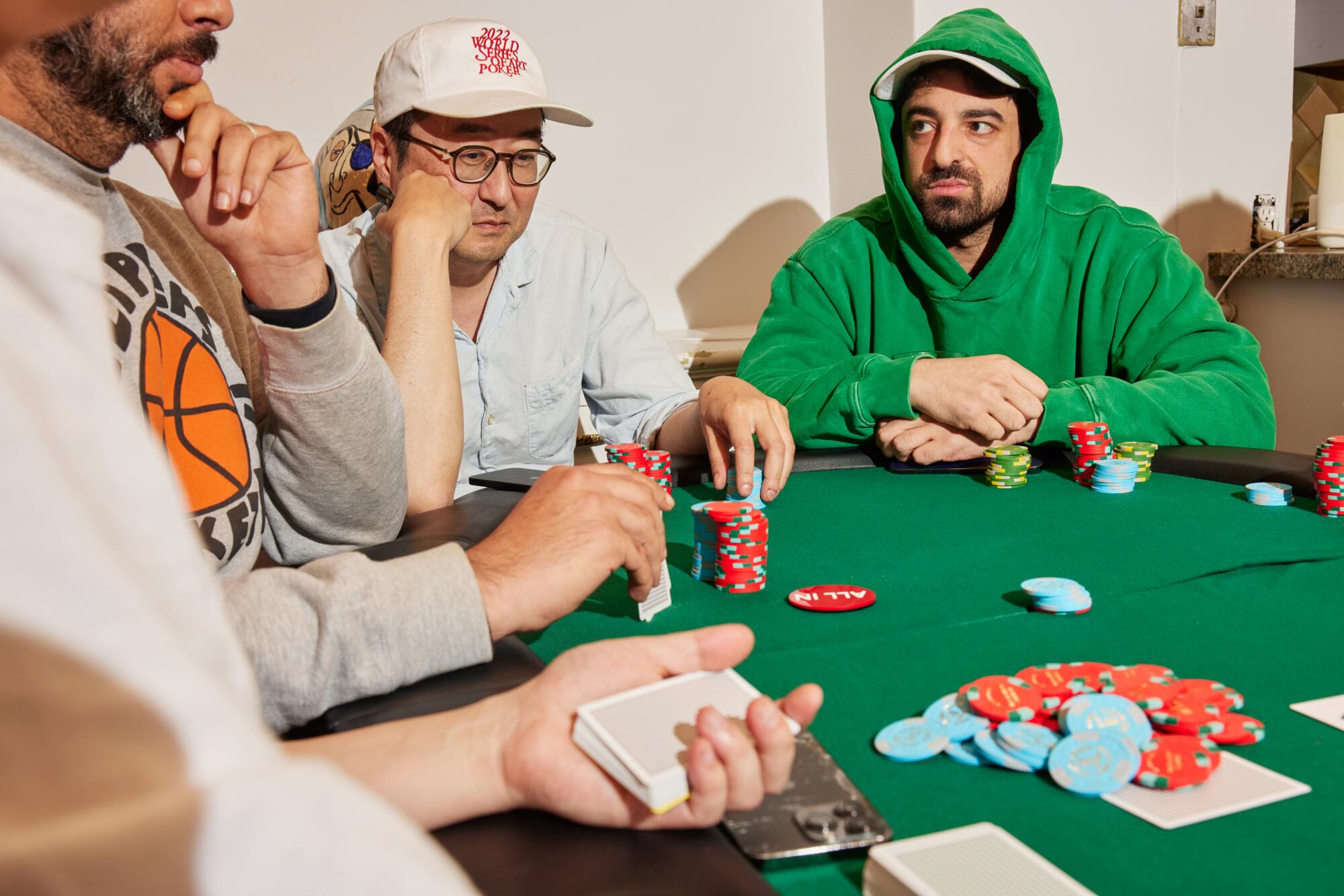
From left, ceramics artist Grant Levy-Lucero, gallerist Eric Kim and collector Jason Roussos are veterans of the high-stakes L.A. poker scene. These days they have more fun playing with their art-world friends, with Kim’s house as a hub.
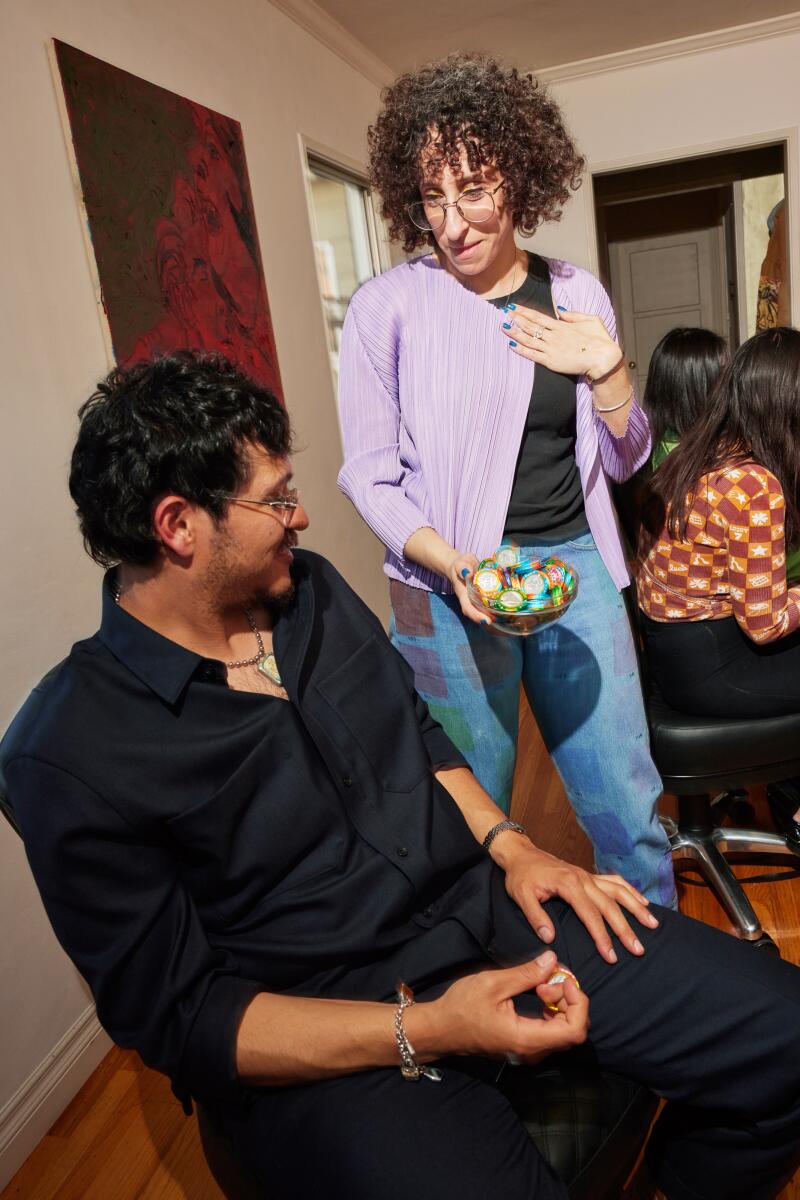
Higinio Martinez and Liz Conn-Hollyn were among the 15 artists who contributed to the poker-themed group exhibit “At Home in the Neon,” held at Eric Kim’s house gallery.
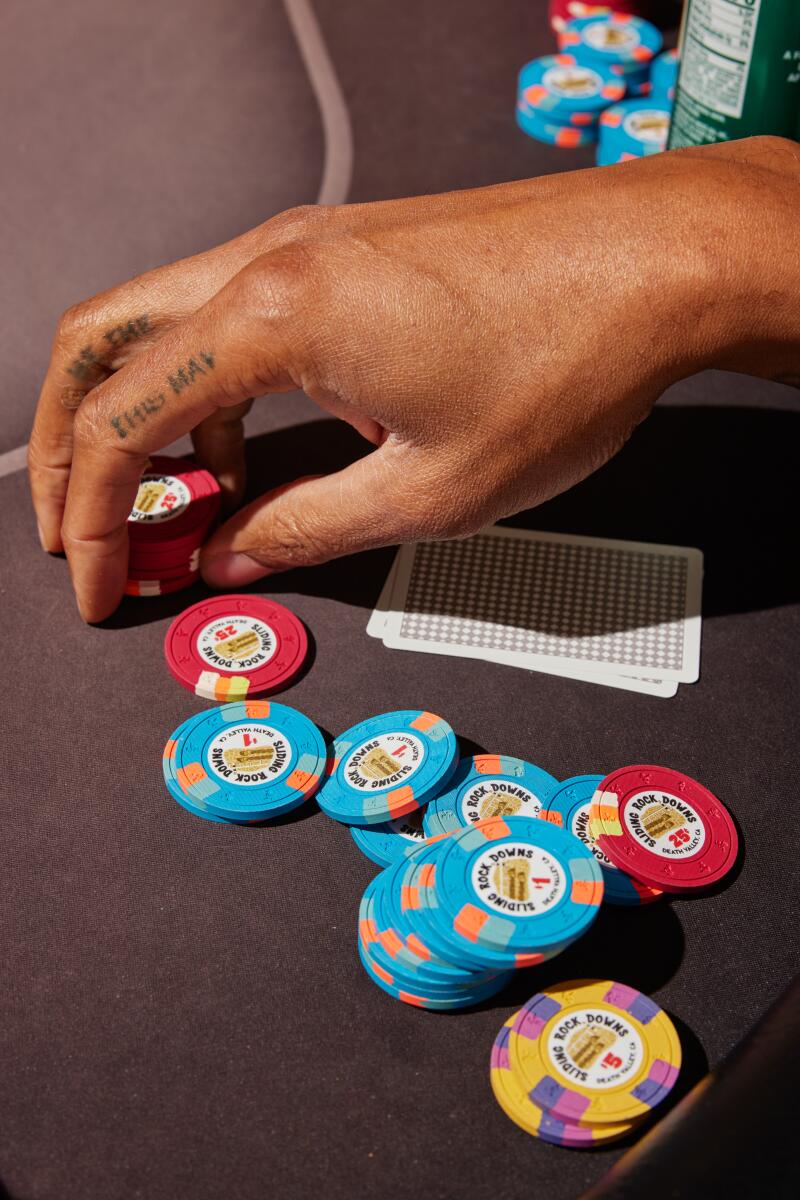
A fraction of gallerist Eric Kim’s collection of 40,000 poker chips.
Eric Kim, who co-runs artist spaces Human Resources and Bel Ami, estimated “poker and art went gangbusters” when online gaming swelled early in the pandemic. After stay-at-home orders lifted, however, he noticed a low-grade culture shock among his friends at crowded openings and art parties. “I think a lot of people enjoyed the contained structure of socializing at a poker game,” he said.
He’s opened his doors to the arts community in the last couple of years, doling out free one-on-one coaching and hosting weekly Hold ’Em nights as a kind of league mentor. The home games draw from his years at casinos and underground venues around L.A. His collection of 40,000 poker chips helps too.
His Silver Lake setup is an equal mix of men and women, newbies and grinders, at varying levels of their careers. Turns out his learning pod had the makings of an artists collective. Kim and Lauren Studebaker, an associate director at Matthew Brown Gallery, staged a poker-themed group show last month. They exhibited work from 15 poker-playing artists around the domestic gallery and called it “At Home in the Neon,” a crib from art critic Dave Hickey’s love letter to Las Vegas.
Julianne Lee, a perfumer, infused plaster chips with a rare scent derived from whale vomit and called it “Who’s the whale” (a reference to a very rich but very bad poker player). Adam Alessi’s good-luck shrine had a rendering of Vanessa Rousso, nicknamed “the lady maverick of poker,” inside. Jake Fagundo’s “Bad Beat” depicted a couple in a warm embrace after a tough loss. “A lot of it was inside jokes for ourselves,” said Studebaker, who paraphrased a wry quote from “The Gambler” by Fyodor Dostoevsky: “You gamble with your friends because you like to see them humiliated.” The group has embraced how the game puts everyone on equal footing. “Losing in front of these people is a fast track to bonding,” she said. “I think the losing has been almost better for me than the winning.”
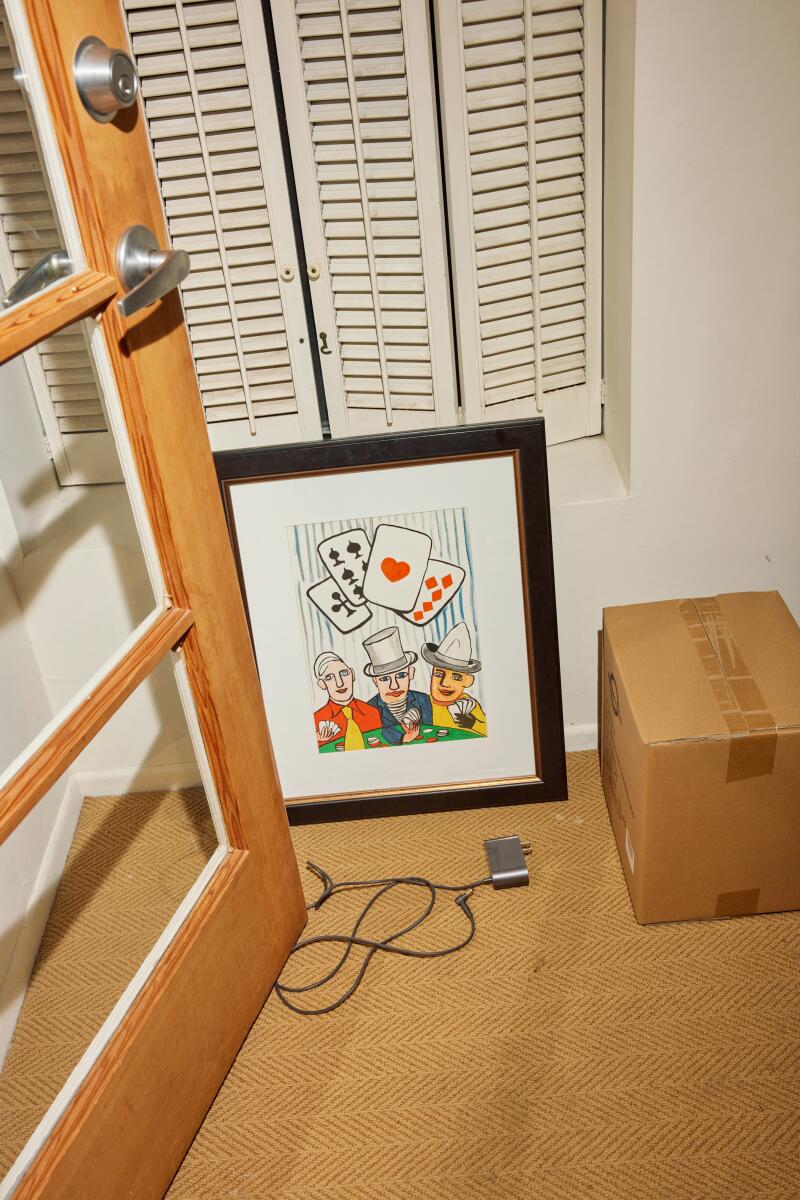
A stray Alexander Calder lithograph of three card players.
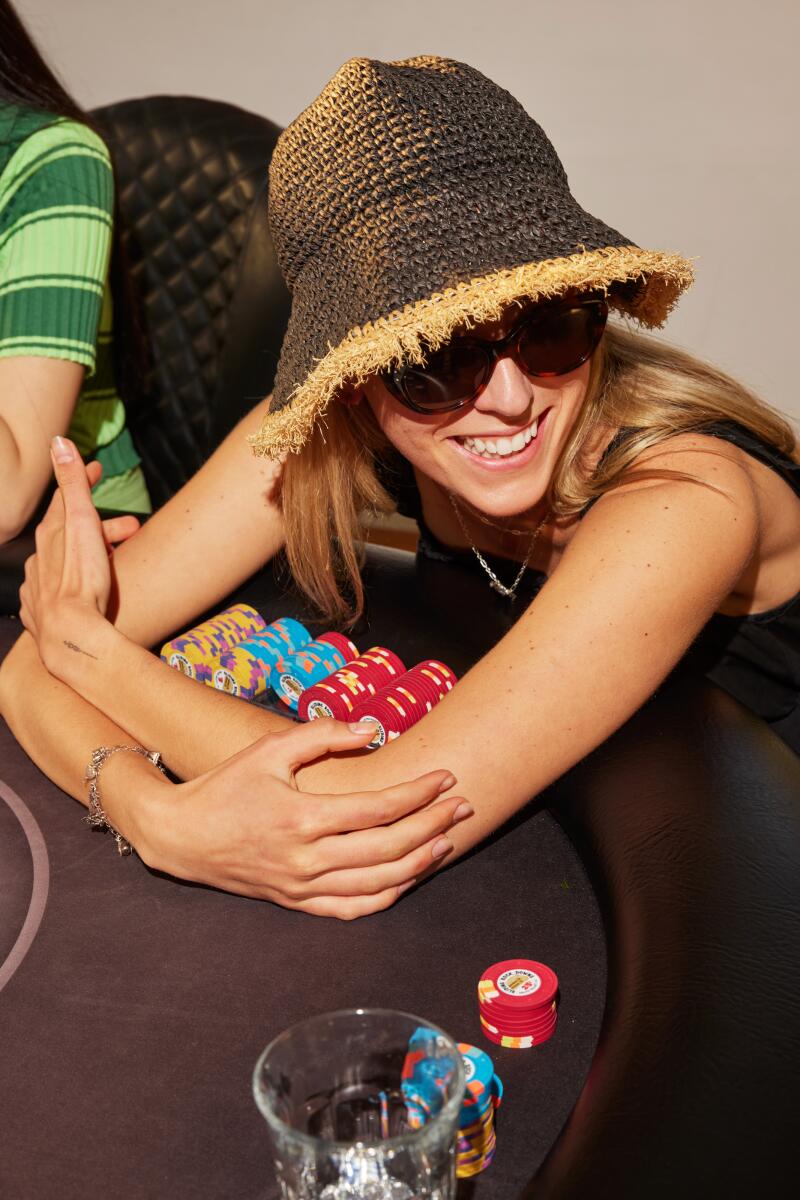
Artist Ava McDonough, another contributor to the poker-themed group show, hugs the pot.
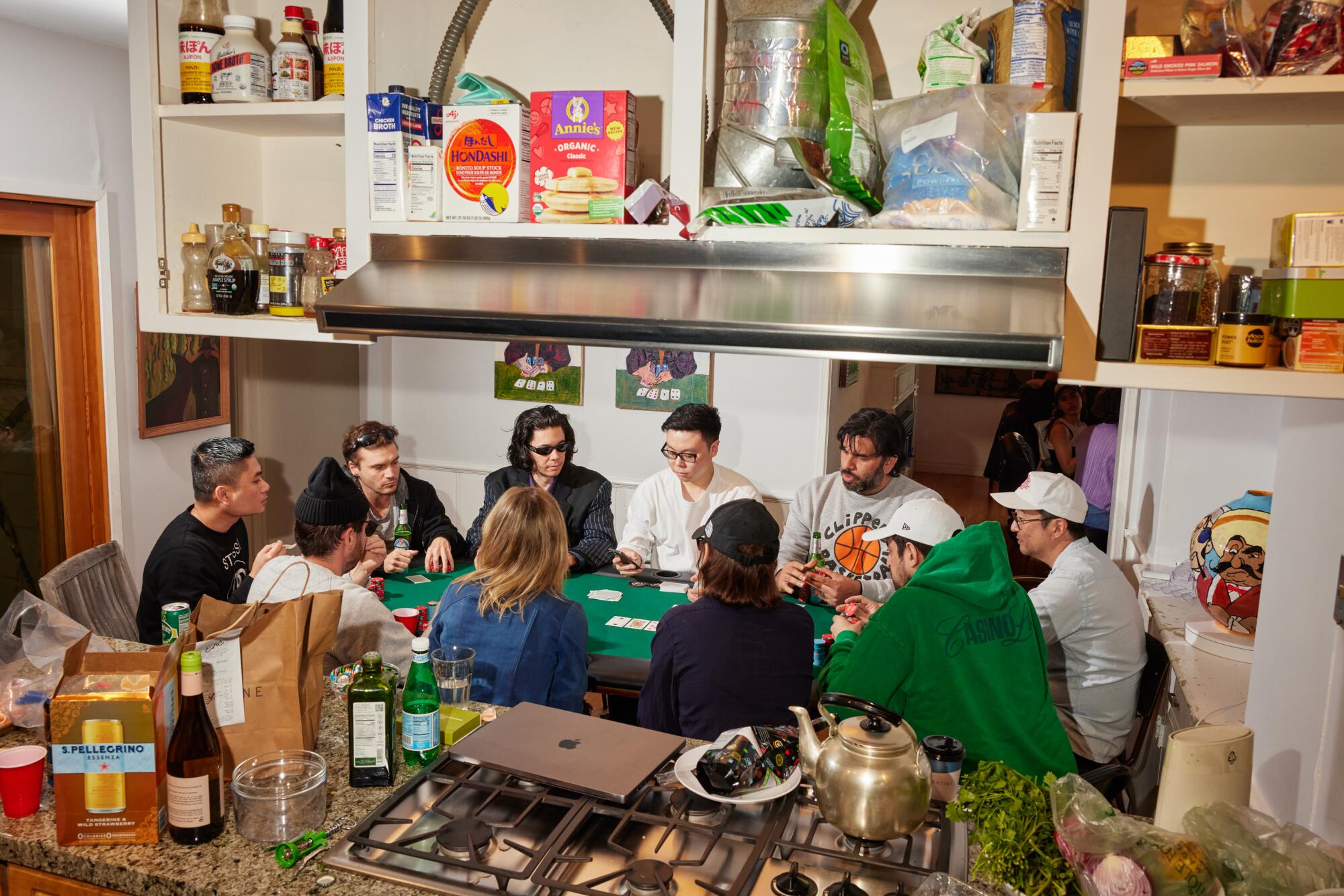
The crowd in the kitchen, including collector Khoi Nguyen and actor Emile Hirsch, at gallerist Eric Kim’s poker game, held at his home. Artwork by Adam Alessi, left, Parker Ito and Grant Levy-Lucero surrounds the table.
The scene’s marquee event today is the annual World Series of Art Poker (WSOAP), a highly guarded, 12-hour Hold ’Em marathon during so-called Frieze Week, when blue-chip galleries and high-rolling collectors jet into town for art fairs and their ensuing parties. “I look forward to it all year,” said artist Parker Ito, who at last year’s heads-up showdown lost to Jason Koon, arguably the best pro poker player today.
At the fourth WSOAP in March, Jonas Wood, “the reigning prince of contemporary painting,” screamed the ceremonial, “Shuffle up and deal.” His Warholian grasp on the art world was on full display as he glad-handed arrivistes from New York and Europe, clad in a sweatsuit made of cash (taken from Warhol’s silkscreen “192 One Dollar Bills,1962”). “This is my conceptual art project,” Wood said of his stylized homage to the early-aughts poker boom, when he came of age in the glow of the 1998 gambling movie “Rounders” and ESPN’s breathless tourney coverage.
Inside, Benny Blanco had his barber give him a lineup at the table. Tobey Maguire busted early but stayed to sweat the last hand of his friend Leonardo DiCaprio. Beyond the $500 buy-in, entry into the stacked poker den has become its own kind of currency, where talk of bad beats and mucked hands replaces the usual industry chatter. The last player standing wins $30,000 and a holy-grail 18-karat gold bracelet modeled after one awarded to the winner of the World Series of Poker.
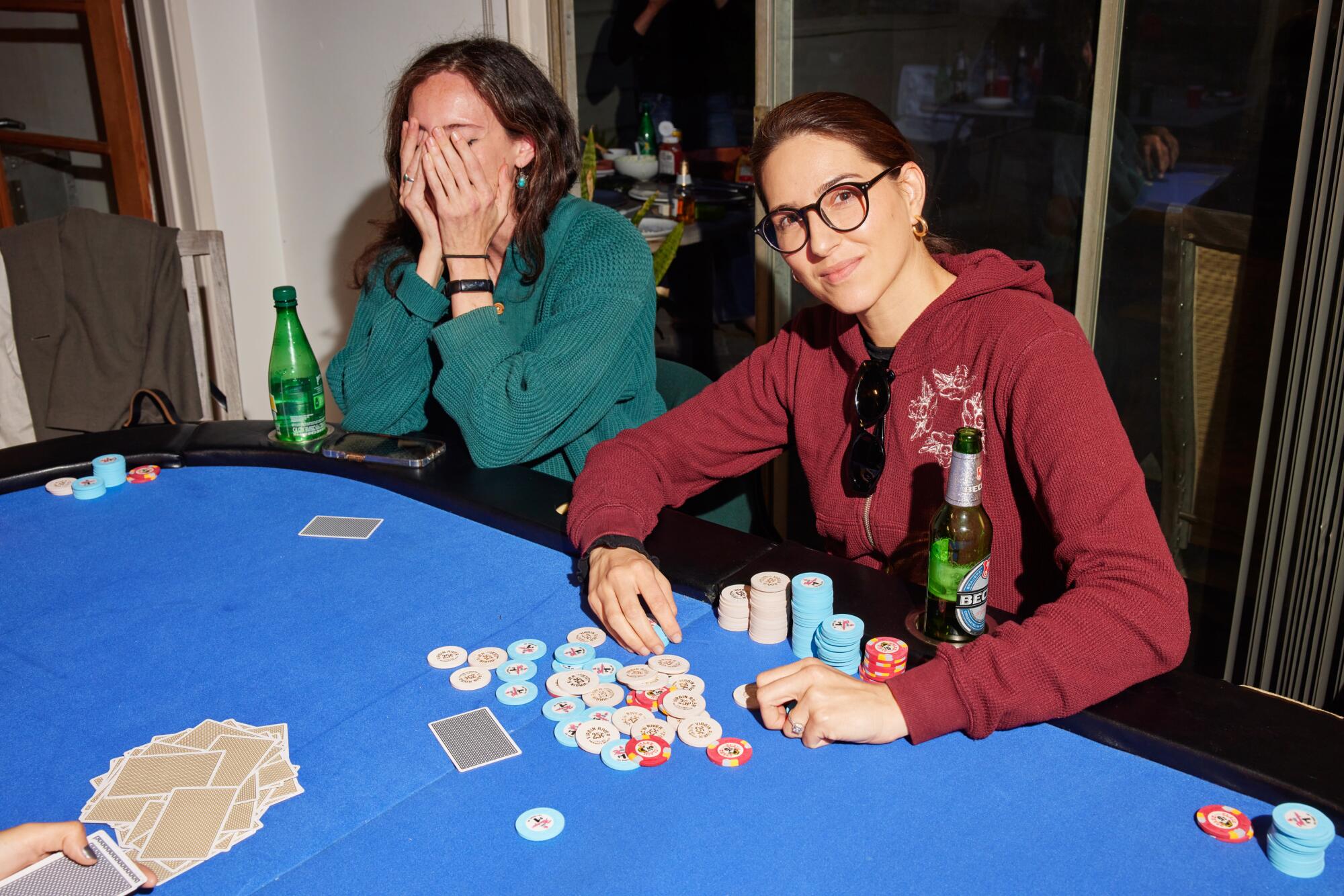
Artist Nihura Montiel has a sly poker face after winning.
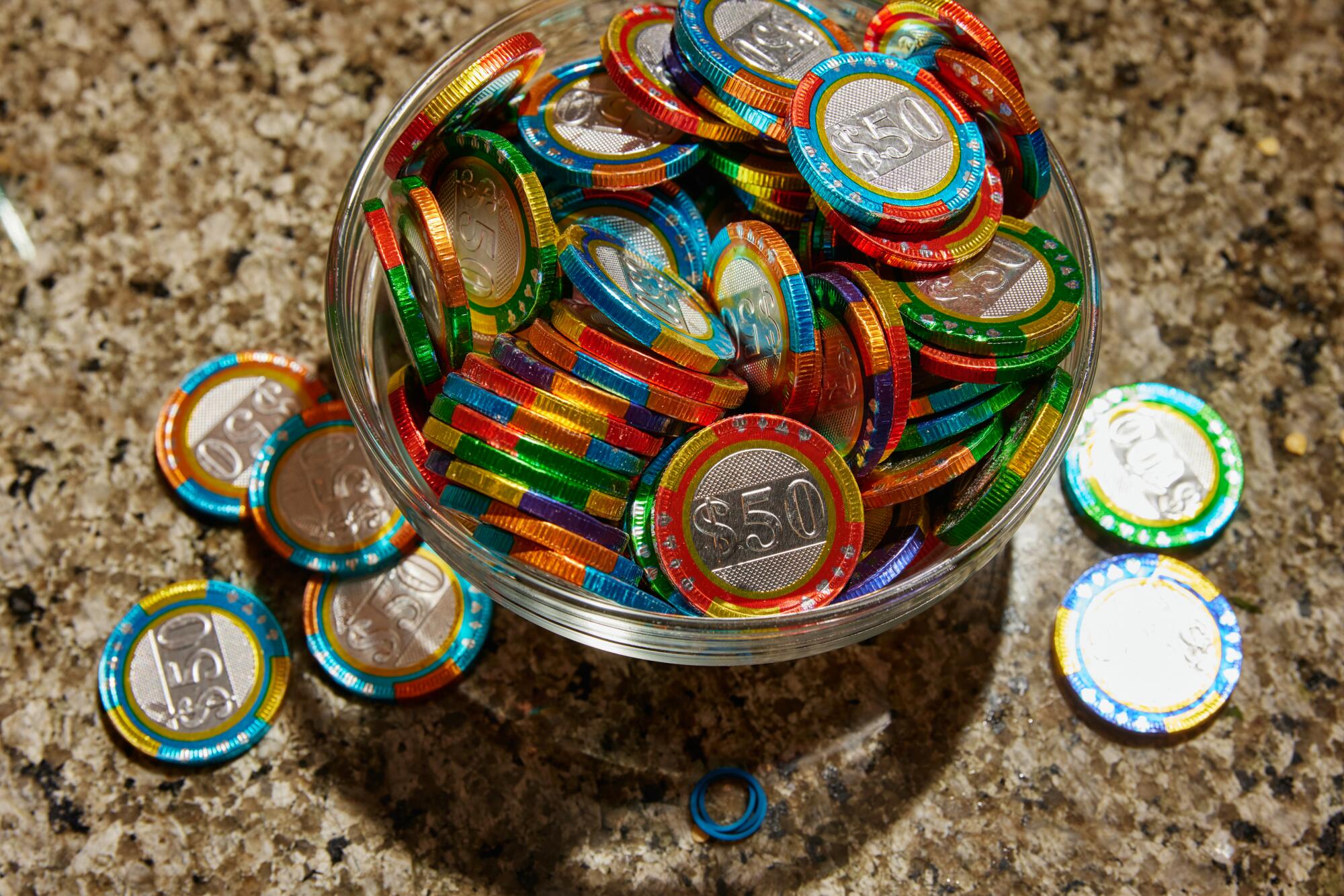
The biggest bluff of the night: chocolate poker chips.
Sophia Amoruso made it to the final 25 out of 130 entrants. “Poker has taught me more patience than anything,” said the Nasty Gal founder and “Girlboss” author, now in venture capital. She’d recently started her own home game after playing after-hours at tech conferences and in VC circles. “To be at the table with the guy who founded Hustler Casino Live, that’s priceless,” she said. “Next week, he’s coming to my house, and I get to learn from him.”
The tournament’s brain trust — Jonas Wood, Eddie Cruz and Eric Kim — rounded up their splinter poker groups to join forces in 2020. “The idea was to find out who’s the best,” Wood recalled. They’d piggyback off Wood’s fabled “art game” in the studio he rented from Ed Ruscha between 2007 and 2017, a revolving door for the city’s “art illuminati,” as Kim put it. Gallerists like Jeff Poe and François Ghebaly rubbed elbows with celebrities like Ellen DeGeneres and Jack Black, and emerging artists faced off against billionaire collectors with increasing regularity.
This year, with past pros like Erik Seidel and Phil Ivey absent from the usual “pros versus Joes” lineup, Wood livestreamed the final tables on Instagram to his 154,000 followers and saw the chance to make good on his original idea to organize the only tournament of its kind — for artists, by artists. He envisioned a wild-card upset winning the biggest pot of their life. It almost happened.
The final 10 players included artists like up-and-coming painter Ross Caliendo, sculptor Matt Johnson and Wood’s ceramist wife, Shio Kusaka. The crowd roared when she was busted out in eighth place — the last woman and artist standing. Michael Heyward, chief executive of the holding company that owns Genius and Worldstar, went on to win. “I really wanted a broke artist or some unknown person to win $30,000,” Wood said.
